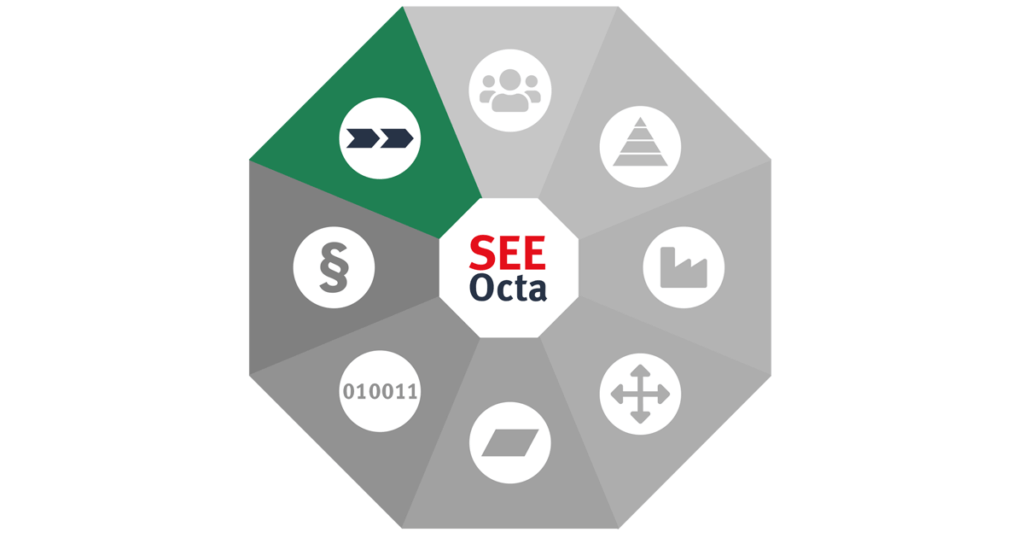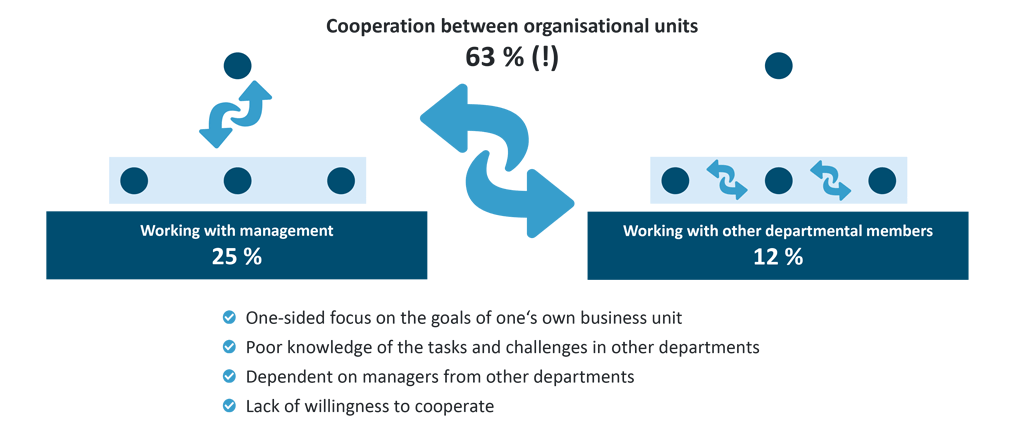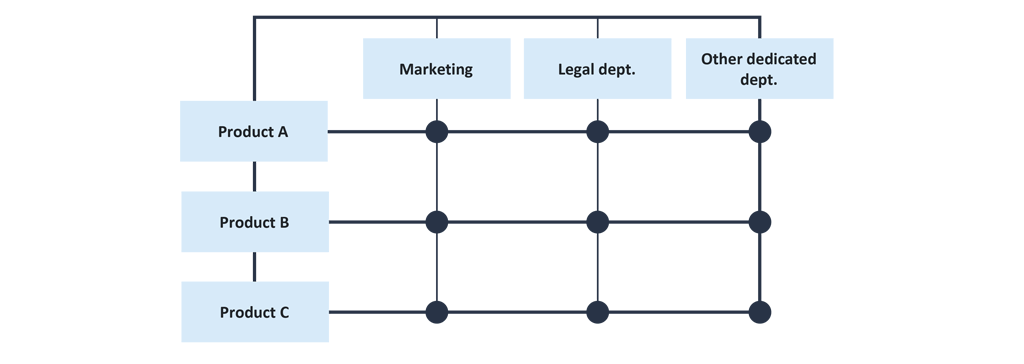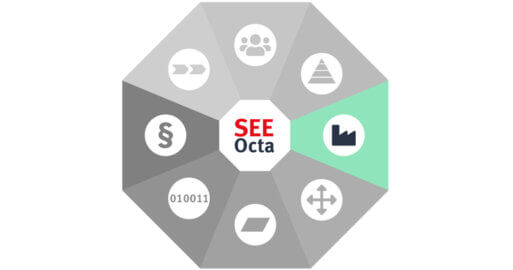SEEOcta: Business Process Reengineering (BPR) – Organisational Structures Part 1

The globalisation in the economy, as well as ever shorter innovation cycles, are forcing a number of organisations to change. New information and communication technologies entering the business world often require completely restructuring an organisational structure, as it only makes sense to install complex new systems once the critical business processes it should support have been analysed, defined and optimised. Many companies use this as an opportunity to shake off old ways of thinking and to redesign their processes to help the company survive in the highly competitive, global economy. Innovative, powerful information technology can also play a key role in helping you optimise your processes.
The SEEOcta blog series explores the topic of project management from eight different perspectives. Discover all the areas you need to consider when planning digitalisation and integration projects in your company. Armed with the ideas and knowledge in the articles, you will have a solid foundation for planning your IT project and a guide to help you ensure that no one gets left behind.
What is business process reengineering (BPR)?
In a nutshell, BPR can be understood as process-orientated business transformation. It’s a concept which was originally developed in 1993 by Michael Hammer and James Champy at the Massachusetts Institute of Technology (MIT), and has been used by companies worldwide ever since. First and foremost, it involves aligning the organisational structure to the business processes. Furthermore, by looking at relevant processes from your customers’ perspective and reengineering them to make them more customer-orientated, you can understand your market better.
Following the four steps of the reengineering process, namely
- Renewing
- Revitalizing
- Reframing
- Restructuring
It can be possible to optimise aspects such as quality, speed, costs and services by over 30%. While we are only taking a quick look at Champy and Hammer’s business process reengineering method here, you can read about it in more detail in the SEEBURGER blog post ʽSEEOcta organisational structure– Business Process Reengineering (BPR) Part 2ʼ, together with its advantages and disadvantages. However, in a nutshell, the focus is on the processes, not on the traditional functions found in an organisation. These days, a number of companies still organise their companies by functional departments, apart from another, with no one responsible for cross-departmental processes. As the adage ‟ process follows structure“ suggests, an organisational structure based on functions promotes a hierarchical, functional way of thinking and acting, which doesn’t create ideal conditions for the business processes to thrive.
- Business Process Reengineering focusses on process, not functions.
Why is business process reengineering important?
The organisational structure determines the hierarchical structure of a company and where departments and jobs stand in relation to one another. By contrast, organisational processes are concerned with where and when work processes are carried out. Both of these perspectives are so interlinked, that optimising one without the other just isn’t possible. This is particularly true for the increasing need to decentralise in order to
- Increasine customer and market orientation
- Redesign the product range
- Concentrate on a company’s core competencies
- Reducine administrative work
- Flattenin hierarchies
This requires tasks and responsibilites to be reassigned, or even removed. New channels of communications need to be opened within an an organisation, all of this at an ever increasing pace of change. Traditional functional structures, centralised and based purely on job type, just can’t support this dynamic environment.

The following research findings underline the importance of a customer-orientated process optimisation, although it’s more important to focus on the message of these findings rather than the numbers per se:
- It costs five times as much to gain a new customer than to keep an existing customer.
- Only 20% or fewer dissatisfied customers share their complaint with you.
- A dissatisfied customer shares his experience with at least nine other people.
- 68 percent of dissatisfied customers are lost due to bad service .
Your customers aren’t bothered about how your company is organised. They just want their expectations to be met and their order, complaint or return to be dealt with quickly and to a high standard. The more an organisation is customer-orientated, the better they can fill their customers‘ expectations. This would require a radical change of thinking in many companies, a full 90 degree turn in how things are done.
Business Process Reengineering – a change of perspective, focussing on processes
Structuring a company based purely on its processes rather than the functions it contains requires a 90 degree shift in thinking. Its organigram is based on processes. This change in perspective means that it is no longer departments specialised in one area of business which determine the processes. Instead, the focus is on the chain of events which get the products developed and made. As the products are designed to be bought by customers, just this change in organisational structure helps towards making your company more customer-orientated.
The consequences in this shift of thinking are:
- Flatter hierarchies with a divisional structure
- Functional and procedural responsibilities are on an equal footing.
- Business processes are fully integrated yet highly autonomous.
- Organisational units consist of business processes, including their sub-processes. They have their own resources and can allocate them as they see fit.

Business Process Reengineering: organise by function, by process or a hybrid?
In the type of organisational structure which is being seen increasingly often these days, organisational units are made up of business processes and their sub-processes, have their own resources, and are responsible for managing these themselves. However, there will still be units based on a function where this makes sense for the company. This type of matrix structure is a hybrid structure in which the processes leading to a product are in autonomous units and run alongside the functional units, which provide their specialist services to the product group as needed.
The advantage of this hybrid organisational structure is that those who have expertise in a certain business skill are still in a dedicated department, where they can liase with and learn from others with the same skills. Their skills and expertise are then made available to the various product divisions – the processes – as and when needed.
Sometimes, this set-up ends up having more in common with a functional organisational structure, with those in the functional departments allocating the resources, and those responsible for the product processes relegated to an organisational role. This sort of company still hasn’t lost its old way of thinking.
However, ideally, the relationship will be comparable to a customer-supplier relationship in which those involved in the processes take on the role of internal customers. They order the skills they need, whether marketing, human resources, procurement, or whatever other functions are in dedicated departments, and the departments supply this in the scope required.

Business Process Reegineering to prepare the way for a new IT system
Business Process Reengineering is a process-oriented business transformation, in which the organisational structure is based on the processes leading to what the customers need. It requires the organisation to undergo radical change with the goal of drastically improving quality, speed, costs and services. A great help here is the creative use of information technology systems, which give employees access to the information they need, wherever they are. Modern information and communication technology can enable you to better support your business processes, making data from various systems available to those who need it regardless of department or system. IT therefore enables you to integrate your business processes better, and gives you new possibilities to lead, manage, liase with external and internal parties, analyse markets and develop and improve products. However, clothing old, inefficient processes in new, expensive hardware and software generally just leads to expensive, inefficient processes. Only automating might actually lead to the rot just being made more efficient. The potential for improvement in this is not high. Simply thinking is not enough to define new processes. Indeed, only taking an inside view often ignores the impact an in-house restructure really has on suppliers, sub-contractors, distributors and customers. In order to end up with an efficient organisation, you need to consider the entire value chain, involving all its stakeholders. Methods in business process reengineering could help you to break out of stale, function-based structures and move towards a more agile structure. Find out more about business process reengineering methods in our next blog post, ʽSEEOcta organisational structures, part 2ʼ.
Thank you for your message
We appreciate your interest in SEEBURGER
Get in contact with us:
Please enter details about your project in the message section so we can direct your inquiry to the right consultant.
Written by: Rolf Holicki
Rolf Holicki, Director BU E-Invoicing, SAP&Web Process, is responsible for the SAP/WEB applications and digitization expert. He has more than 25 years of experience in e-invoicing, SAP, Workflow and business process automation. Rolf Holicki has been with SEEBURGER since 2005.



